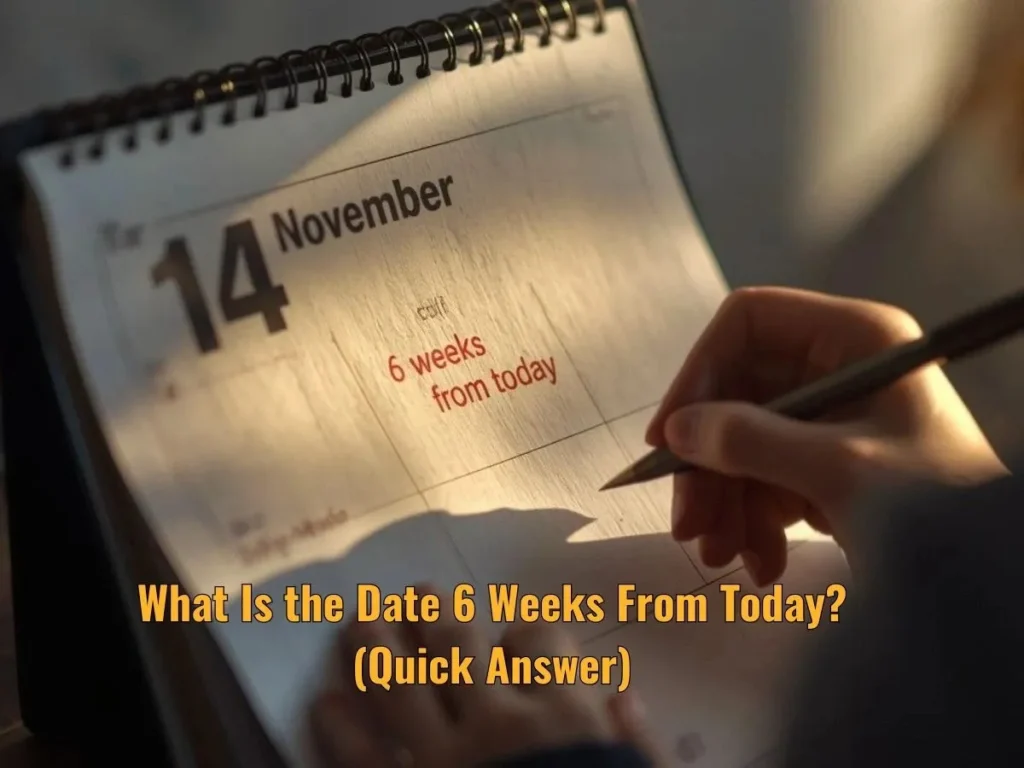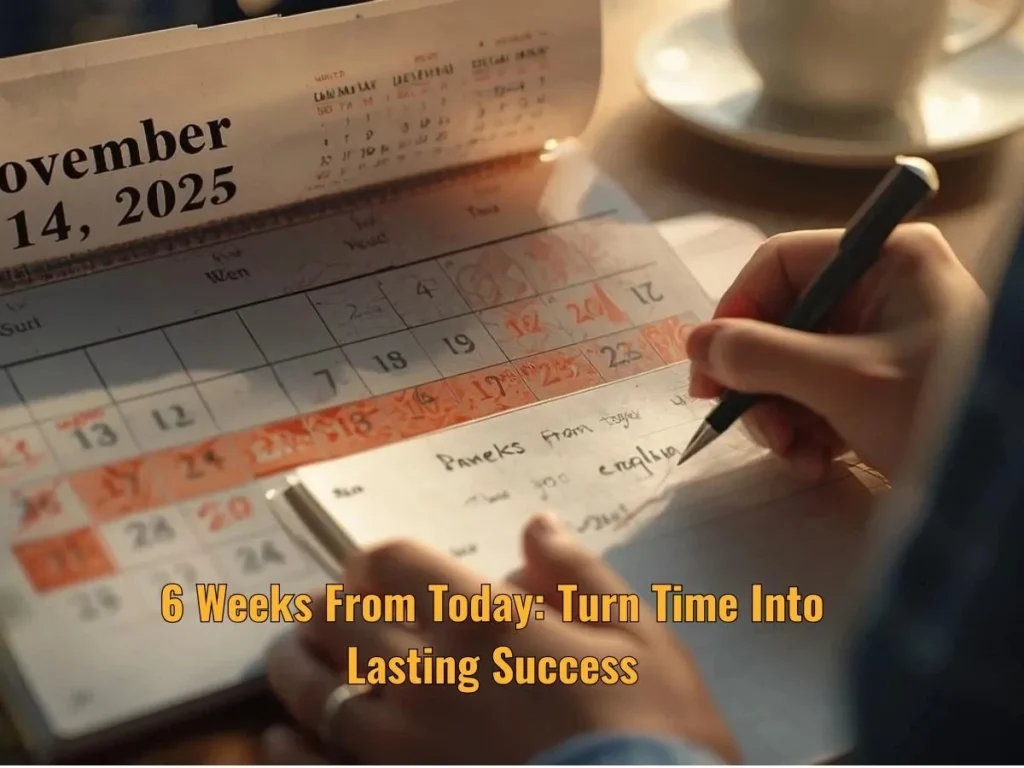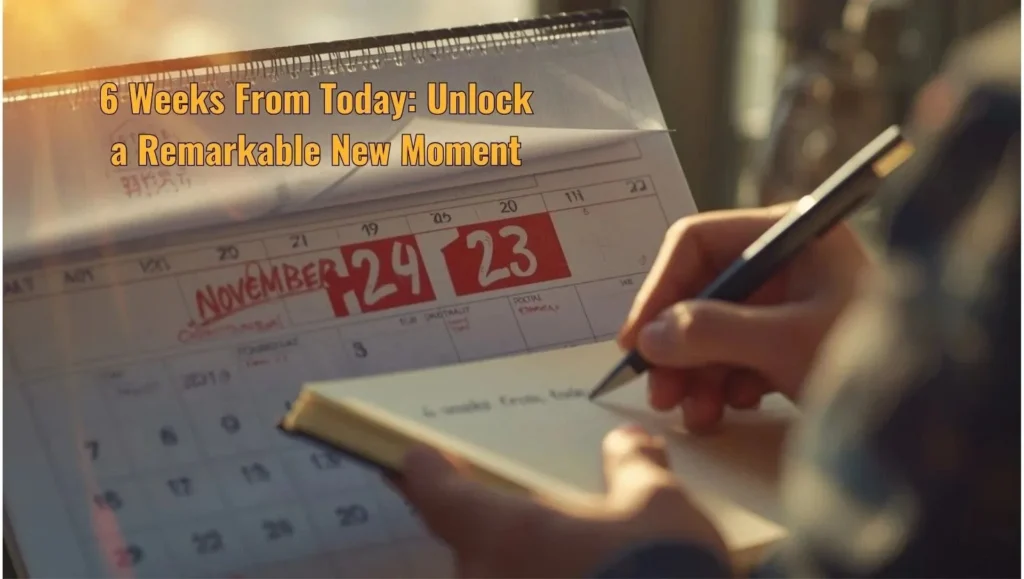Introduction
6 weeks from today might seem like a simple calculation, but knowing that exact date can make a big difference in how you plan ahead.
Whether you’re planning an event, purchasing a new investment property, planning a trip or even tracking a pregnancy milestone, having access to the future date ranges of all the events in your life offers clarity and control.
This guide doesn’t just tell you what the date in six weeks will be, it also tells you how to figure that out quickly, why this information is useful and how to use it for more easeful life, work and goal planning.
What Is the Date 6 Weeks From Today? (Quick Answer)

Simple math is the easiest way to find out. Six weeks is equal to 42 days (6 × 7). So, 6 weeks from today is November 10, 2025 and it’s a Monday.
Here’s a quick reference table for clarity:
| Calculation | Result |
| Days Ahead | 42 days |
| Hours Ahead | 1,008 hours |
| Minutes Ahead | 60,480 minutes |
| Seconds Ahead | 3,628,800 seconds |
That’s the simple answer for planners, countdowns and those wanting to schedule an exact future date.
How to Calculate 6 Weeks From Today (Manual & Tool Methods)
The date can be measured manually or digitally. They are both effective, depending on the situation.
Manual Calculation
If you like to get your hands dirty:
Start with today’s date.
Add 42 days.
Count forward using a calendar or date chart.
Example: If you began on October 1, 2025 → then +42 days → it will be November 12, 2025.
Using Excel or Google Sheets
- Type =TODAY()+42 in a cell and you’ll get the date exactly six weeks from now.
- Or, to add from a certain date in cell A1, enter =A1+42.
Using an Online Calculator
A 6 weeks today calender can show:
- Times the date and day of the week
- The choice to exclude weekends or holidays
- Count down timers that are shareable or export to calendar
Why It’s Useful to Know the Date 6 Weeks From Today
Answer to the question “what is the date 6 weeks from today?” is not only simple curiosity it’s practical. Six weeks is long enough for actual progress, and short enough to try not to lose motivation.
This is why we love this interval so much:
In Everyday Life
- Project management: Establish 6-week sprint cycles for measurable goals.
- Pregnancy tracking: A lot of prenatal checkups go by weeks.
- Event planning: Wish guest lists, orders or logistics six weeks ahead of an event.
- Fitness or wellness: Keep track of progress in a six-week challenge.
- Work notice periods: This is often a way HR people will calculate resignations or starting dates.
How Long Is 6 Weeks in Days, Hours, and Minutes?
To visualize this duration clearly:
| Time Unit | Equivalent |
| 6 Weeks | 42 Days |
| 6 Weeks | 1,008 Hours |
| 6 Weeks | 60,480 Minutes |
| 6 Weeks | 3,628,800 Seconds |
The ability to recall these conversions can aid professionals and students in their calculations of time, particularly when they are trying to schedule the hours worked, studied or programmed.
6 Weeks From Today in Different Time Zones
“Today doesn’t look the same everywhere when the team is spread across around the world and collaborate globally.” If it’s a Monday morning in New York, for example, it is already Monday evening in London and Tuesday in Tokyo.
Key Considerations
- Time zones: Make sure to check which zone the date is using.
- Daylight saving: Changes to meeting times may be made within this six-week period.
- Business travel: International schedules can lead to one-day variations.
Planning Ahead With 6-Week Goals
Six weeks is a common planning cycle recommended by many productivity experts. It is long enough to get serious work done, but short enough that we can focus sufficiently.
How to Add 6 Weeks From Today to Your Calendar
When you add the date to your digital calendar, you will never forget important dates.
Steps for Google Calendar
- Open your calendar.
- Select “+ Create Event.”
- Include title of event (such as Project Review – 6 Weeks From Today).
- Set the date 42 days ahead.
- Reminds two weeks and three days in advance.
For Outlook or Apple Calendar
Do the same or import an. ics file they had got from some date finding tool. And many tools have one-click integration with “Add to Google Calendar” among other options.
This makes it easy to automate subsequent reminders and synchronize them between devices.
Practical Uses of Knowing 6 Weeks From Today
Professionals may as well use the same date calculation for various purposes:
Students
- Schedule six-week study blocks with a practice or exam each week.
- Align dates of submission and mock tests with the upcoming schedules.
- Review “what day is 6 weeks from today” for course planning.
Professionals
- Establish sprint goals or short-term project deadlines.
- Handle timelines around notice periods and onboarding.
- Determine deadlines for reports or marketing cycles.
Families
- Plan vacations, pay your bills, attend family events all at least six weeks ahead.
- Countdown apps for children that incorporate a sense of excitement about birthdays or holidays.
This timescale should apply to both work and personal life in order to make your aspirations manageable.
Troubleshooting: Why Results Might Differ
If your due date doesn’t line up with someone else’s, these may be the culprit:
- Time zone disparities: Someone’s “today” could be another person’s “tomorrow.”
- Without working days: Ensure the same calculation mode is used by both sides.
- Format mismatch: Nations differ on the order of day, month and year in dates.
- Daylight saving time changes: Here the times of day can be changed, but not the date.
And finally, always check with a traditional date and time lookup to avoid confusion.
The Science Behind Weekly Timeframes
Why do we mark the progress of human development in weeks? Studies have found that the human brain works best when it schedules tasks either into consistent, short blocks or consistent, long ones.
Six weeks is just right it’s long enough to establish new habits, but short enough that the motivation of a novice exerciser can remain high and initial results are tangible.
Psychology supports this idea through the infamous 42-day rule, which suggests it takes about six weeks to form a new habit or pattern.
Similarly, project management teams often work in six-week sprints, a structure that balances focused creativity with manageable deadlines to reduce burnout and boost productivity.
When it comes to learning, breaking a subject into six-week study cycles helps information stick more effectively through repetition and consistent engagement.
Neurologically, our brains are programmed to look for short-term wins.
And breaking large goals into sections of six weeks gives you the dopamine-fueled satisfaction of realizing that you’ve made progress without getting constipated by long-term pressure.
Whether it’s a new habit or lifestyle change, an initiative for work (big or small), tracking performance, conducting an experiment, etc., six weeks fosters consistency, brings clarity and provides a metric to see your growth over time allowing time to be turned into tangible framework for successful living.
6 Weeks From Today: Turn Time Into Lasting Success

The idea of short, intense periods of time is powerful because it allows you to show definitive progress without losing steam.
In addition to the right attitude, a six-week window is also perfect because it strikes a balance between ambition and discipline it’s long enough so that you can start to see things change yet short enough that you won’t lose momentum.
For personal growth, health goals, or professional development, the six-week approach provides a framework for your vision and a way to act with intent.
Here’s how you can use this theory in practice:
- Goal Setting: Divide long-term goals into six-week increments. Have one major goal, set up mini-goals and celebrate the process on a weekly basis.
- Health & Fitness: Record workouts, dietary changes or wellness habits throughout six weeks and see actual improvement in energy levels, strength or your mindset.
- Career Development: During this time, you can become proficient in a new skill, finish off a certification or increase productivity with tools like time blocking.
- Budgeting/Financial Planning: Save, budget, or write down all your costs for 6 weeks so you can look at your spending habits and build financial discipline.
- Personal Projects: Learning a hobby, writing a book, or redecorating your house will have enough time to keep you on it and accountable.
Imagine what life might look like six weeks from today, the possibilities that consistent effort affords you.
All by dedicating to one concentrated phase, progress you now can sense, measure, and be greatly rewarded for within an achievable time frame of motivation ..
Conclusion
Now that you know how to calculate what is 6 weeks from today, the same principles can be used to find out what’s the date 6 weeks in the future.
Whether you’re tracking deadlines, studying for finals or planning personal goals, you’ll have the just-right combination of structure and space.
Take advantage of this time period to set realistic targets, track consistent progress, and stay motivated without burning out.
Put the date in your digital diary and set some reminders; make each week count! You’ll be inspired with small, doable actions you can take each week for six weeks that will set you up for big wins, keeping your life organized, making sure you’re feeling confident and in control of your calendar.
FAQs
What is 6 weeks from today?
It is the specific date that is 42 days from today.
How do I calculate 6 weeks from today in my head?
Add forty-two days to today’s date using a date calculator or calendar.
Why do we commonly plan on six weeks?
But long enough that people might start to be able to see results, and it’s short enough to keep the pressure on.
What’s the date, six weeks back from today?
It means the date 42 days before today’s date.
The 6 week rule, how can I apply it to personal goals?
Select a target number, measure progress every week and evaluate after six weeks.




